Brinks Home Security 2703-130 Guía de instalación
- Tipo
- Guía de instalación

1"
25,4 mm
1
2
3
4
5
6
a
a
b
a
b
b c
a
b
(S1)
c,d
d
c
a
Prepare Door Jamb for Strike Plate
a. Mark centerline on the door jamb exactly opposite the latch
hole.
b. Drill two 7/8" (22 mm) holes about 5/8" (16 mm) deep. The
holes should overlap by about 1/2" (13 mm). Use a chisel to
clean up the edges.
c. Center the Strike Plate over the hole. Trace the outline with a
pencil, then chisel the jamb approximately 1/16" (1.6 mm)
deep or until the Strike Plate is flush with the jamb.
d. See Step 8 for Strike Plate installation.
Selecting the Proper Backset
a. Backset is the distance from the door edge to the center of
the 2-1/8" (54 mm) hole on the door face.
b. The latch can be adjusted to fit either a 2-3/8" (60 mm) or a
2-3/4" (70 mm) Backset. The 2-3/8" Backset is common for
residential doors.
c. To adjust the Backset, move the Cam with the square hole
towards the latch bolt for the 2-3/8" (60 mm) Backset or
towards the rear of the latch for the 2-3/4" (70 mm) Backset.
Install Latch
a. Select appropriate faceplate (square or round corners) to
match the cutout in the door edge.
b. To change the faceplate, carefully separate the faceplate from
the latch using a flathead screwdriver. Align and "snap" on the
desired faceplate.
c. Insert the latch into the 1" hole in the door edge as shown.
Be sure the bevelled face of the latch bolt is towards the door
jamb.
d. Insert two (S1) Latch Screws in the faceplate holes and
tighten.
Install Outside Knob or Lever
a. Insert the square spindle of the Outside Knob or Lever
through the square hole in the latch. Press flush against the
door face.
b. For Keyed Entry locksets, the keyhole must be oriented as
shown.
If installing into a door with an existing hole that is less than
2-1/8" (54 mm) in diameter, you may choose to remove the
Anti-Pry Shield instead of re-drilling the door. To remove the
Anti-Pry Shield, remove the two attachment screws. Removal
of the Anti-Pry Shield will not affect the function of the lockset.
NOTE:
INSTALLATION INSTRUCTIONS FOR TUBULAR
KNOB AND LEVER HANDLE LOCKSETS
FOR BRINKS KEYED ENTRY, INTERIOR LOCKING, AND INTERIOR
NON-LOCKING KNOB AND LEVER HANDLE LOCKSETS
For Replacement Installation Instructions,
Remove existing door lock, latch assembly, and strike plate and begin at Step 4.
For New Installation Instructions,
Begin at Step 1
OUTSIDE LEVER
KEYS (2)*
PRIVACY KEY
INSIDE LEVER
ANTI-PRY SHIELD*
OUTSIDE KNOB
LATCH
(S2) MACHINE SCREWS (2)
INSIDE KNOB
STRIKE PLATE
(S3) STRIKE PLATE SCREWS (2)**
(S1) LATCH SCREWS (2)**
*WITH KEYED ENTRY LOCK ONLY
BED & BATH INTERIOR LOCKSETS ARE PROVIDED
WITH A PRIVACY KEY FOR LOCKING & UNLOCKING
ALTHOUGH A FLATHEAD SCREWDRIVER WILL ALSO
WORK.
BED & BATH AND HALL & CLOSET LOCKSETS ARE PROVIDED
WITH FOUR (S1) LATCH SCREWS, WHICH ARE USED FOR BOTH
LATCH AND STRIKE INSTALLATION.
OUTSIDE KNOB
b
b
a
a
OUTSIDE LEVER
PERILLA EXTERIOR
MANIJA EXTERIOR
Mark Door with Template
b.
Drill Holes
a. Drill a 2-1/8" (54 mm) hole on door face from both sides to
avoid splitting the wood.
b. Drill a 1" (25.4 mm) hole for latch.
c. Insert latch into hole, mark outline of faceplate, and chisel 1/8"
(3 mm) deep or until the faceplate is flush with the door edge.
2-3/8" BACKSET (60 mm)
2-3/4" BACKSET (70 mm)
CAM
2-3/8" - or - 2-3/4"
7/8"
DIAMETER
1/2"
2-1/8"
54 mm
38"
965 mm
38"
965 mm
**
MANIJA EXTERIOR
LLAVES (2)*
MANIJA INTERIOR
ESCUDO ANTIPALANCA*
PERILLA EXTERIOR
CERROJO
TORNILLOS (S2) PARA METAL (2)
PERILLA INTERIOR
PLACA DE LA
HEMBRA DEL
CERROJO
TORNILLOS (S3) DE PLACA HEMBRA (2)**
TORNILLOS (S1)
DE CERROJO (2)**
*PARA CERRADURAS DE ENTRADA CON LLAVE
**
LLAVE DE PRIVACIDAD
SE PROVEEN LOS CONJUNTOS DE CERROJOS PARA
PUERTAS INTERIORES DE RECÁMARAS Y BAÑOS
CON UNA LLAVE DE PRIVACIDAD PARA CERRAR Y
ABRIR AUNQUE TAMBIÉN SE PUEDE UTILIZAR UN
DESARMADOR PLANO.
Instale el Cerrojo
a. Seleccione la placa frontal (esquinas cuadradas o redondeadas)
para igualar el rebajo en el borde de la puerta.
b. Para cambiar la placa frontal, separe cuidadosamente la placa
frontal del cerrojo mediante el uso de un desarmador plano.
Alinee y “empuje” en la placa frontal deseada.
c. Inserte el cerrojo en el agujero de 25.4 mm (1") en el canto o
borde de la puerta tal como se muestra. Asegúrese que la cara
biselada del pasador del cerrojo se encuentra hacia la jamba de
la puerta.
d. Inserte dos Tornillos (S1) del cerrojo a través de los orificios en
la placa frontal y apriételos firmemente.
Instale la Perilla o Manija exterior
a. Inserte el huso cuadrado de la Perilla o Manija exterior a
través del agujero cuadrado en el cerrojo. Empuje hasta
quedar al ras de la cara de la puerta
b. Para los Conjuntos de entrada con llave, el ojo de la llave debe
quedar orientado tal como se muestra.
Si se instala en una puerta con agujero ya existente que tiene
un diámetro inferior a 54 mm (2-1/8"), usted puede decidir
realizar la instalación sin el Escudo antipalanca en vez de
volver a perforar la puerta. Para quitar el Escudo antipalanca,
desmonte los dos tornillos de sujeción. El hecho de desmontar
el Escudo antipalanca no afecta de manera alguna el
funcionamiento del conjunto de cerrojo.
NOTA:
a.
b.
c.
b.
c.
d.
a.
b.
c.
DIÁMETRO
22 mm
13 mm
DISTANCIA DE 60 mm (2-3/8")
DISTANCIA DE 70 mm (2-3/4")
LEVA
60 mm - o - 70 mm
SQUARE CORNER
FACEPLATE
PLACA FRONTAL
CON ESQUINAS
CUADRADAS
LOS CONJUNTOS DE CERRADURAS PARA RECÁMARAS Y
BAÑOS, Y PARA PASILLOS Y CLOSETS, SE PROPORCIONAN CON
CUATRO TORNILLOS (S1) DE CERROJO, LOS CUALES SE
UTILIZAN TANTO PARA LA INSTALACIÓN DEL CERROJO COMO
DE LA PLACA HEMBRA
INSTRUCCIONES DE INSTALACIÓN PARA CONJUNTOS DE
CERRADURA DE PERILLA TUBULAR Y MANIJA DE PALANCA
PARA CONJUNTOS DE CERRADURA DE BRINKS DE PERILLA Y PALANCA
DE ENTRADA E INTERIORES CON LLAVE, E INTERIORES SIN LLAVE
Instrucciones para instalación de reemplazo:
Quite la cerradura, el cerrojo y la hembra del cerrojo instaladas y empiece en el
Paso 4.
Instrucciones para instalación nueva:
Empiece en el Paso 1.
Marque la Puerta con la Plantilla
a. Marque la línea central para el juego de cerradura
aproximadamente a 965 mm (38") del piso.
b.
Perfore los Agujeros
Perfore un agujero de 54 mm (2-1/8") en la cara de la puerta por
ambos lados para evitar astillar la madera.
Perfore un agujero de 25.4 mm (1") para el cerrojo.
Inserte el cerrojo en el agujero; marque el contorno de la placa
frontal, y utilice un formón para quitar una capa de madera de
3 mm (1/8") de profundidad o hasta que la placa frontal quede al
ras del borde o canto de la puerta.
Prepare la Jamba de la puerta para la Placa de la
hembra del cerrojo
a. Marque la línea central en la jamba de la puerta en posición
exactamente opuesta al agujero del cerrojo.
Perfore dos orificios de (22 mm) 7/8" a aproximadamente 16 mm
(5/8") de profundidad. Los orificios deben tener un traslape de
aproximadamente 13 mm (1/2"). Use un formón para limpiar los
bordes.
Centre la Placa de la hembra del cerrojo sobre el agujero. Marque
el contorno con un lápiz; luego use un formón para quitar una
capa de madera de 1.6 mm (16") de profundidad o hasta que la
Placa de la hembra del cerrojo quede al ras de la jamba.
Vea la instalación de la Placa de la hembra del cerrojo en el
Paso 8.
Cómo seleccionar la distancia o “entrada” correcta
La distancia del canto o borde de la puerta hasta el centro del
agujero de 54 mm (2-1/8") en la cara de la puerta se le conoce
algunas veces como “entrada”.
El cerrojo se puede ajustar para que quepa ya sea en una
distancia o“entrada” de 60 mm (2-3/8") o de 70 mm (2-3/4"). La
distancia o “entrada” de 60 mm (2-3/8") es común para puertas
residenciales.
Para ajustar la distancia o “entrada”, mueva la Leva con el agujero
cuadrado hacia el pasador del cerrojo para la distancia o
“entrada” de 60 mm (2-3/8") o hacia la parte posterior del cerrojo
para la distancia o “entrada” de 70 mm (2-3/4").
c.
d.
Seleccione una distancia o “entrada” (del canto o borde) de
60 mm (2-3/8") o de 70 mm (2-3/4") según corresponda y marque
el centro del agujero en la cara de la puerta. (La mayoría de las
puertas residenciales tienen una distancia del canto o borde de la
puerta de 60 mm (2-3/8").
Marque el centro del agujero del cerrojo en el canto de la puerta
de acuerdo con el espesor de su puerta.
a. Mark the center line for the lockset about 38” (965 mm)
from the floor.
c.
b.
d.
Select 2-3/8" (60 mm) or 2-3/4" (70 mm) backset as desired
and mark center of hole on door face. (Most residential doors
have a 2-3/8" backset.)
Mark the center for the latch hole on the door edge according
to the thickness of your door.
Apply the template to the door with the dotted fold line on the
door edge.
Coloque la plantilla sobre la puerta con la línea punteada de
doblez en el borde de la puerta.

(S3)
(S2)
(S2)
a
d
INSIDE KNOB
ROSE
ROSETA
THUMBTURN
MARIPOSA DEL SEGURO
LATCH BOLT
DEADLOCKING
PLUNGER
STRIKE PLATE
PLACA DE LA
HEMBRA DEL
CERROJO
INSIDE LEVER
PERILLA INTERIOR
MANIJA INTERIOR
ROSE
ROSETA
THUMBTURN
MARIPOSA DEL SEGURO
PASADOR DEL CERROJO
ÉMBOLO DE CIERRE DE SEGURIDAD
7
Install Inside Knob or Lever
a. Before installing the Inside Knob or Lever, place the
Thumbturn in a horizontal or vertical orientation as desired
(both orientations will work).
b. Slide the Inside Knob or Lever over the square spindle until
flush with the door.
c. Insert the two (S2) Machine Screws through the holes in
the rose and tighten firmly. For Lever installation, the lever
handle must be rotated to gain access to the second
screw hole.
8
Install Strike Plate
a. For Keyed Entry Locksets (new installation) - position the
Strike Plate so that the latch bolt is extended into the hole in
the Strike Plate while the deadlocking plunger is depressed
by the Strike Plate. (For a replacement installation, replace
the Strike Plate if desired or needed.)
b. For Bed and Bath or Hall and Closet Locksets, position the
Strike Plate so that the latch bolt is extended into the hole in
the Strike Plate. (The latches with these locksets do not
have a deadlocking plunger.)
c. For Keyed Entry Locksets: While holding the Strike Plate
in position, mark the screw hole locations and drill two 5/32"
(4 mm) pilot holes for the screws. Insert two (S3) Strike
Plate Screws through the holes in the Strike Plate and
tighten firmly.
d. For Bed and Bath or Hall and Closet Locksets: While
holding the Strike Plate in position, mark the screw hole
locations and drill two 1/8" (3 mm) pilot holes for the
screws. Insert two (S1) Latch Screws through the
holes in the Strike Plate and tighten firmly.
9
Reverse Levers If Necessary
a. Levers should always be installed with the handle pointing
towards the hinges of the door.
b. For levers with a "curl" or "wave" design, the tip should
point down to achieve best fit for your hand.
c. If your lever has its tip pointing up, the Inside and Outside
Levers need to be switched.
d. Be sure the Lever Lockset is unlocked.
e. Locate the hole at the base of the neck on the Outside
Lever. Using the Lever Tool provided, push into the hole on
the catch while pulling the lever away from the lock chassis.
Leave the cylinder in the spindle. If it comes out, replace it.
f. Repeat this step for the Inside Lever.
g.
NOTE:
Now slide the lever that you removed from the inside onto
the outside spindle until it clicks into place. Slide the other
lever onto the inside spindle until it clicks into place. Test
lock with key and thumbturn for proper operation.
Example shows Keyed Entry lock. Bed & Bath and
Hall & Closet locks do not have cylinders.
Instale la Perilla o Manija interior
a. Antes de instalar la Perilla o Manija interior, coloque la
Mariposa del seguro con la orientación vertical u horizontal
deseada (ambas orientaciones funcionarán).
b. Deslice la Perilla o Manija interior por sobre el huso cuadrado
hasta quedar al ras de la puerta.
c. Inserte los dos Tornillos (S2) para metal a través de los
orificios en la roseta y apriételos firmemente. Para instalar la
Manija, la manija debe ser girada para tener acceso al agujero
del segundo tornillo.
Para invertir las Manijas en caso necesario
a. Las manijas siempre debe ser instaladas con la manija
apuntando hacia las bisagras de la puerta.
b. Para las palancas con un diseño de “rizo” o de “onda”, la
punta debe apuntar hacia abajo para lograr el mejor ajuste
para su mano.
c. Si su manijas tiene su punta apuntando hacia arriba, las
Manijas interior y exterior debe ser intercambiadas.
d. Asegúrese que el Conjunto de cerrojo de palanca no este
cerrado con seguro.
e. Ubique el agujero en la base del cuello en la Manija exterior.
Con la Herramienta de manija provista, empuje hacia el
interior del agujero sobre el dispositivo de cierre a la vez que
jala la manija del bastidor del cerrojo. Deje el cilindro en el
huso. Si sale el cilindro, reemplácelo.
f. Repita este paso para la Manija interior.
g.
NOTA:
Ahora deslice la manija que usted desmontó del lado
interior por sobre el huso exterior hasta que entra a presión.
Deslice la otra manija por sobre el huso interior hasta que
entra a presión. Pruebe la cerradura con la llave y la mariposa
de seguro para verificar el funcionamiento correcto.
El ejemplo muestra una cerradura con Acceso con llave. Las
cerraduras de Recámaras y Baños y de Pasillos y Clósets no
tienen cilindros.
Hampton Products International Corp.
50 Icon
Foothill Ranch, CA 92610-3000 USA
www.hamptonproducts.com
1-800-562-5625
© 2009 Hampton Products International Corp.
999-00252 REVA 06/09
Brink's trademark & copyright work are
used with permission.
Doble a lo largo de la línea punteada y
coloque sobre el borde de la puerta
Perfore un agujero de 25.4 mm (1”) en el centro del
borde o canto de la puerta
45mm
40mm
35mm
PLANTILLA
Para una distancia o “entrada” de 70 mm (2-3/4”)
Para una distancia o “entrada” de 60 mm (2-3/8”)
Se adapta a un agujero de cilindro
de 54 mm (2-1/8”)
For backset 2-3/4" (70mm)
For backset 2-3/8" (60mm)
Fits 2-1/8" (54mm) cylinder hole
Fold on dotted line and fit on door edge
Make a 1" (25.4mm) hole at center of door edge
C
L
C
L
C
L
1-3/4"
1-9/16"
1-3/8"
TEMPLATE
Instale la Placa de la Hembra del cerrojo
a.
Para los Conjuntos de entrada con llave (en una instalación
nueva) coloque la Placa de la hembra del cerrojo de manera tal
que el pasador del cerrojo se extiende hacia el interior del
agujero en la Placa de la hembra del cerrojo, mientras que el
émbolo de cierre de seguridad es presionado por la Placa de la
hembra del cerrojo. (En caso de instalación de reemplazo, se
puede reemplazar la placa de la hembra del cerrojo si así se
requiere o se desea.)
b.
Para los Conjuntos de recámara o de baño y closet, coloque la
Placa de la hembra del cerrojo de tal manera que el pasador del
cerrojo se extiende hacia el interior del agujero de la Placa de la
hembra, (Los cerrojos en estos conjuntos de cerradura no
incluyen el émbolo de cierre de seguridad.)
c.
Para los Conjuntos de entrada con llave : Mientras sostiene la
Placa de la hembra en posición, marque las ubicaciones de los
agujeros de los tornillos y perfore dos agujeros piloto de 4 mm
(5/32") para los tornillos. Inserte dos Tornillos (S3) de la Placa
hembra del cerrojo a través de los agujeros en la Placa hembra
del cerrojo y apriételos firmemente.
d.
Para los Conjuntos de recámara o de baño y closet : Mientras
sostiene la Placa de la hembra en posición, marque las
ubicaciones de los agujeros de los tornillos y perfore dos
agujeros piloto de 3 mm (1/8") para los tornillos. Inserte dos
Tornillos (S3) de la Placa hembra del cerrojo a través de los
agujeros en la Placa hembra del cerrojo y apriételos firmemente.
TIP POINTING DOWN
CORRECT CORRECTO
INCORRECT INCORRECTO
PUNTA DIRIGIDA
HACIA ABAJO
TIP POINTING UP
PUNTA DIRIGIDA
HACIA ARRIBA
b
c
SPINDLE
HUSO
CYLINDER
CILINDRO
e
f
g
LEVER TOOL
HERRAMIENTA DE MANIJA
CATCH HOLE
AGUJERO DE
DISPOSITIVO DE CIERRE
DESPUÉS
AFTER
ANTES
BEFORE
e
LIFETIME WARRANTY - This product is fully warranted to be free of defects in material and workmanship for the life of the product. If a defect in material or workmanship occurs, call 800-562-5625 for instructions on how to have it
replaced or repaired free of charge. This warranty is null and void if the product was used for purposes for which it was not designed, is abused, misused, modified or improperly installed, operated, maintained, and/or repaired. NOT LIABLE
FOR INCIDENTAL, INDIRECT, OR CONSEQUENTIAL DAMAGES. Some states do not allow the exclusion or limitation of incidental or consequential damages, so the above limitation or exclusion may not apply to you. This warranty gives
you specific rights, and you may also have other rights that vary from state to state.
Se utilizan con autorización la marca
registrada y los trabajos con derechos
reservados de Brink.
GARANTÍA DE POR VIDA - Este producto está totalmente garantizado de no tener defectos en materiales y mano de obra durante la vida del producto. Si ocurre un defecto en materiales o en la mano de obra, llame al teléfono 800-562-5625
para obtener instrucciones sobre cómo poder reemplazarlo o reparado sin costo alguno. Esta garantía es nula y sin valor si el producto se utilizó para objetivos para el que no fue diseñado, o sufre abuso, mal uso, es modificado o instalado,
accionado, mantenido y/o es reparado incorrectamente. NO HAY RESPONSABILIDAD ALGUNA POR DAÑOS INCIDENTALES O INDIRECTOS. Algunos estados no permiten la exclusión o limitación de daños incidentales o indirectos, por lo
que esta exclusión puede no ser aplicable a usted. Esta garantía le proporciona derechos legales y usted podrá tener otros derechos que varían de estado a estado.
Transcripción de documentos
INSTALLATION INSTRUCTIONS FOR TUBULAR KNOB AND LEVER HANDLE LOCKSETS INSTRUCCIONES DE INSTALACIÓN PARA CONJUNTOS DE CERRADURA DE PERILLA TUBULAR Y MANIJA DE PALANCA FOR BRINKS KEYED ENTRY, INTERIOR LOCKING, AND INTERIOR NON-LOCKING KNOB AND LEVER HANDLE LOCKSETS PARA CONJUNTOS DE CERRADURA DE BRINKS DE PERILLA Y PALANCA DE ENTRADA E INTERIORES CON LLAVE, E INTERIORES SIN LLAVE For Replacement Installation Instructions, (S2) MACHINE SCREWS (2) Instrucciones para instalación de reemplazo: Remove existing door lock, latch assembly, and strike plate and begin at Step 4. TORNILLOS (S2) PARA METAL (2) For New Installation Instructions, Instrucciones para instalación nueva: Begin at Step 1 INSIDE LEVER MANIJA INTERIOR Quite la cerradura, el cerrojo y la hembra del cerrojo instaladas y empiece en el Paso 4. Empiece en el Paso 1. OUTSIDE LEVER MANIJA EXTERIOR LATCH CERROJO SQUARE CORNER FACEPLATE PLACA FRONTAL CON ESQUINAS CUADRADAS PRIVACY KEY LLAVE DE PRIVACIDAD ANTI-PRY SHIELD* ESCUDO ANTIPALANCA* BED & BATH INTERIOR LOCKSETS ARE PROVIDED WITH A PRIVACY KEY FOR LOCKING & UNLOCKING ALTHOUGH A FLATHEAD SCREWDRIVER WILL ALSO WORK. INSIDE KNOB PERILLA INTERIOR SE PROVEEN LOS CONJUNTOS DE CERROJOS PARA PUERTAS INTERIORES DE RECÁMARAS Y BAÑOS CON UNA LLAVE DE PRIVACIDAD PARA CERRAR Y ABRIR AUNQUE TAMBIÉN SE PUEDE UTILIZAR UN DESARMADOR PLANO. (S1) LATCH SCREWS (2)** TORNILLOS (S1) DE CERROJO (2)** STRIKE PLATE PLACA DE LA HEMBRA DEL CERROJO (S3) STRIKE PLATE SCREWS (2)** TORNILLOS (S3) DE PLACA HEMBRA (2)** KEYS (2)* LLAVES (2)* *PARA CERRADURAS DE ENTRADA CON LLAVE **BED & BATH AND HALL & CLOSET LOCKSETS ARE PROVIDED WITH FOUR (S1) LATCH SCREWS, WHICH ARE USED FOR BOTH LATCH AND STRIKE INSTALLATION. **LOS CONJUNTOS DE CERRADURAS PARA RECÁMARAS Y BAÑOS, Y PARA PASILLOS Y CLOSETS, SE PROPORCIONAN CON CUATRO TORNILLOS (S1) DE CERROJO, LOS CUALES SE UTILIZAN TANTO PARA LA INSTALACIÓN DEL CERROJO COMO DE LA PLACA HEMBRA OUTSIDE KNOB PERILLA EXTERIOR 1 Mark Door with Template Marque la Puerta con la Plantilla a. Mark the center line for the lockset about 38” (965 mm) from the floor. b. Apply the template to the door with the dotted fold line on the door edge. c. Select 2-3/8" (60 mm) or 2-3/4" (70 mm) backset as desired and mark center of hole on door face. (Most residential doors have a 2-3/8" backset.) d. Mark the center for the latch hole on the door edge according to the thickness of your door. a. Marque la línea central para el juego de cerradura aproximadamente a 965 mm (38") del piso. b. Coloque la plantilla sobre la puerta con la línea punteada de doblez en el borde de la puerta. c. Seleccione una distancia o “entrada” (del canto o borde) de 60 mm (2-3/8") o de 70 mm (2-3/4") según corresponda y marque el centro del agujero en la cara de la puerta. (La mayoría de las puertas residenciales tienen una distancia del canto o borde de la puerta de 60 mm (2-3/8"). d. Marque el centro del agujero del cerrojo en el canto de la puerta de acuerdo con el espesor de su puerta. 2 Drill Holes Perfore los Agujeros a. Drill a 2-1/8" (54 mm) hole on door face from both sides to avoid splitting the wood. b. Drill a 1" (25.4 mm) hole for latch. c. Insert latch into hole, mark outline of faceplate, and chisel 1/8" (3 mm) deep or until the faceplate is flush with the door edge. a. Perfore un agujero de 54 mm (2-1/8") en la cara de la puerta por ambos lados para evitar astillar la madera. b. Perfore un agujero de 25.4 mm (1") para el cerrojo. c. Inserte el cerrojo en el agujero; marque el contorno de la placa frontal, y utilice un formón para quitar una capa de madera de 3 mm (1/8") de profundidad o hasta que la placa frontal quede al ras del borde o canto de la puerta. 3 Prepare Door Jamb for Strike Plate Prepare la Jamba de la puerta para la Placa de la hembra del cerrojo 38" 965 mm b a 2-1/8" 1" 25,4 mm 54 mm a c a 7/8" DIAMETER DIÁMETRO 22 mm 1/2" 13 mm 38" 965 mm a. Mark centerline on the door jamb exactly opposite the latch hole. b. Drill two 7/8" (22 mm) holes about 5/8" (16 mm) deep. The holes should overlap by about 1/2" (13 mm). Use a chisel to clean up the edges. c. Center the Strike Plate over the hole. Trace the outline with a pencil, then chisel the jamb approximately 1/16" (1.6 mm) deep or until the Strike Plate is flush with the jamb. d. See Step 8 for Strike Plate installation. d b CAM LEVA b a *WITH KEYED ENTRY LOCK ONLY 4 c Selecting the Proper Backset a. Backset is the distance from the door edge to the center of the 2-1/8" (54 mm) hole on the door face. b. The latch can be adjusted to fit either a 2-3/8" (60 mm) or a 2-3/4" (70 mm) Backset. The 2-3/8" Backset is common for residential doors. c. To adjust the Backset, move the Cam with the square hole towards the latch bolt for the 2-3/8" (60 mm) Backset or towards the rear of the latch for the 2-3/4" (70 mm) Backset. /4" 2-3 m m r- o - 70 " /8 o 2-3 m m 60 2-3/8" BACKSET (60 mm) DISTANCIA DE 60 mm (2-3/8") a b 2-3/4" BACKSET (70 mm) DISTANCIA DE 70 mm (2-3/4") 5 Install Latch 6 Install Outside Knob or Lever c,d a. Select appropriate faceplate (square or round corners) to match the cutout in the door edge. b. To change the faceplate, carefully separate the faceplate from the latch using a flathead screwdriver. Align and "snap" on the desired faceplate. c. Insert the latch into the 1" hole in the door edge as shown. Be sure the bevelled face of the latch bolt is towards the door jamb. d. Insert two (S1) Latch Screws in the faceplate holes and tighten. (S1) b OUTSIDE LEVER MANIJA EXTERIOR OUTSIDE KNOB PERILLA EXTERIOR a a b a. Insert the square spindle of the Outside Knob or Lever through the square hole in the latch. Press flush against the door face. b. For Keyed Entry locksets, the keyhole must be oriented as shown. NOTE: If installing into a door with an existing hole that is less than 2-1/8" (54 mm) in diameter, you may choose to remove the Anti-Pry Shield instead of re-drilling the door. To remove the Anti-Pry Shield, remove the two attachment screws. Removal of the Anti-Pry Shield will not affect the function of the lockset. a. Marque la línea central en la jamba de la puerta en posición exactamente opuesta al agujero del cerrojo. b. Perfore dos orificios de (22 mm) 7/8" a aproximadamente 16 mm (5/8") de profundidad. Los orificios deben tener un traslape de aproximadamente 13 mm (1/2"). Use un formón para limpiar los bordes. c. Centre la Placa de la hembra del cerrojo sobre el agujero. Marque el contorno con un lápiz; luego use un formón para quitar una capa de madera de 1.6 mm (16") de profundidad o hasta que la Placa de la hembra del cerrojo quede al ras de la jamba. d. Vea la instalación de la Placa de la hembra del cerrojo en el Paso 8. Cómo seleccionar la distancia o “entrada” correcta a. La distancia del canto o borde de la puerta hasta el centro del agujero de 54 mm (2-1/8") en la cara de la puerta se le conoce algunas veces como “entrada”. b. El cerrojo se puede ajustar para que quepa ya sea en una distancia o“entrada” de 60 mm (2-3/8") o de 70 mm (2-3/4"). La distancia o “entrada” de 60 mm (2-3/8") es común para puertas residenciales. c. Para ajustar la distancia o “entrada”, mueva la Leva con el agujero cuadrado hacia el pasador del cerrojo para la distancia o “entrada” de 60 mm (2-3/8") o hacia la parte posterior del cerrojo para la distancia o “entrada” de 70 mm (2-3/4"). Instale el Cerrojo a. Seleccione la placa frontal (esquinas cuadradas o redondeadas) para igualar el rebajo en el borde de la puerta. b. Para cambiar la placa frontal, separe cuidadosamente la placa frontal del cerrojo mediante el uso de un desarmador plano. Alinee y “empuje” en la placa frontal deseada. c. Inserte el cerrojo en el agujero de 25.4 mm (1") en el canto o borde de la puerta tal como se muestra. Asegúrese que la cara biselada del pasador del cerrojo se encuentra hacia la jamba de la puerta. d. Inserte dos Tornillos (S1) del cerrojo a través de los orificios en la placa frontal y apriételos firmemente. Instale la Perilla o Manija exterior a. Inserte el huso cuadrado de la Perilla o Manija exterior a través del agujero cuadrado en el cerrojo. Empuje hasta quedar al ras de la cara de la puerta b. Para los Conjuntos de entrada con llave, el ojo de la llave debe quedar orientado tal como se muestra. NOTA: Si se instala en una puerta con agujero ya existente que tiene un diámetro inferior a 54 mm (2-1/8"), usted puede decidir realizar la instalación sin el Escudo antipalanca en vez de volver a perforar la puerta. Para quitar el Escudo antipalanca, desmonte los dos tornillos de sujeción. El hecho de desmontar el Escudo antipalanca no afecta de manera alguna el funcionamiento del conjunto de cerrojo. INSIDE LEVER MANIJA INTERIOR INSIDE KNOB PERILLA INTERIOR ROSE ROSETA (S2) THUMBTURN MARIPOSA DEL SEGURO DEADLOCKING PLUNGER ÉMBOLO DE CIERRE DE SEGURIDAD 8 Install Strike Plate 9 Reverse Levers If Necessary d STRIKE PLATE PLACA DE LA HEMBRA DEL CERROJO b Install Inside Knob or Lever ROSE (S2) ROSETA THUMBTURN MARIPOSA DEL SEGURO LATCH BOLT PASADOR DEL CERROJO a 7 (S3) c CORRECT CORRECTO INCORRECT INCORRECTO TIP POINTING UP PUNTA DIRIGIDA HACIA ARRIBA TIP POINTING DOWN PUNTA DIRIGIDA HACIA ABAJO BEFORE ANTES Instale la Perilla o Manija interior a. Before installing the Inside Knob or Lever, place the Thumbturn in a horizontal or vertical orientation as desired (both orientations will work). b. Slide the Inside Knob or Lever over the square spindle until flush with the door. c. Insert the two (S2) Machine Screws through the holes in the rose and tighten firmly. For Lever installation, the lever handle must be rotated to gain access to the second screw hole. a. Antes de instalar la Perilla o Manija interior, coloque la Mariposa del seguro con la orientación vertical u horizontal deseada (ambas orientaciones funcionarán). b. Deslice la Perilla o Manija interior por sobre el huso cuadrado hasta quedar al ras de la puerta. c. Inserte los dos Tornillos (S2) para metal a través de los orificios en la roseta y apriételos firmemente. Para instalar la Manija, la manija debe ser girada para tener acceso al agujero del segundo tornillo. Instale la Placa de la Hembra del cerrojo a. For Keyed Entry Locksets (new installation) - position the Strike Plate so that the latch bolt is extended into the hole in the Strike Plate while the deadlocking plunger is depressed by the Strike Plate. (For a replacement installation, replace the Strike Plate if desired or needed.) b. For Bed and Bath or Hall and Closet Locksets, position the Strike Plate so that the latch bolt is extended into the hole in the Strike Plate. (The latches with these locksets do not have a deadlocking plunger.) c. For Keyed Entry Locksets: While holding the Strike Plate in position, mark the screw hole locations and drill two 5/32" (4 mm) pilot holes for the screws. Insert two (S3) Strike Plate Screws through the holes in the Strike Plate and tighten firmly. d. For Bed and Bath or Hall and Closet Locksets: While holding the Strike Plate in position, mark the screw hole locations and drill two 1/8" (3 mm) pilot holes for the screws. Insert two (S1) Latch Screws through the holes in the Strike Plate and tighten firmly. a. Para los Conjuntos de entrada con llave (en una instalación nueva) coloque la Placa de la hembra del cerrojo de manera tal que el pasador del cerrojo se extiende hacia el interior del agujero en la Placa de la hembra del cerrojo, mientras que el émbolo de cierre de seguridad es presionado por la Placa de la hembra del cerrojo. (En caso de instalación de reemplazo, se puede reemplazar la placa de la hembra del cerrojo si así se requiere o se desea.) b. Para los Conjuntos de recámara o de baño y closet, coloque la Placa de la hembra del cerrojo de tal manera que el pasador del cerrojo se extiende hacia el interior del agujero de la Placa de la hembra, (Los cerrojos en estos conjuntos de cerradura no incluyen el émbolo de cierre de seguridad.) c. Para los Conjuntos de entrada con llave : Mientras sostiene la Placa de la hembra en posición, marque las ubicaciones de los agujeros de los tornillos y perfore dos agujeros piloto de 4 mm (5/32") para los tornillos. Inserte dos Tornillos (S3) de la Placa hembra del cerrojo a través de los agujeros en la Placa hembra del cerrojo y apriételos firmemente. d. Para los Conjuntos de recámara o de baño y closet : Mientras sostiene la Placa de la hembra en posición, marque las ubicaciones de los agujeros de los tornillos y perfore dos agujeros piloto de 3 mm (1/8") para los tornillos. Inserte dos Tornillos (S3) de la Placa hembra del cerrojo a través de los agujeros en la Placa hembra del cerrojo y apriételos firmemente. Para invertir las Manijas en caso necesario a. Levers should always be installed with the handle pointing towards the hinges of the door. b. For levers with a "curl" or "wave" design, the tip should point down to achieve best fit for your hand. c. If your lever has its tip pointing up, the Inside and Outside Levers need to be switched. d. Be sure the Lever Lockset is unlocked. e. Locate the hole at the base of the neck on the Outside Lever. Using the Lever Tool provided, push into the hole on the catch while pulling the lever away from the lock chassis. Leave the cylinder in the spindle. If it comes out, replace it. f. Repeat this step for the Inside Lever. g. Now slide the lever that you removed from the inside onto the outside spindle until it clicks into place. Slide the other lever onto the inside spindle until it clicks into place. Test lock with key and thumbturn for proper operation. NOTE: Example shows Keyed Entry lock. Bed & Bath and Hall & Closet locks do not have cylinders. e a. Las manijas siempre debe ser instaladas con la manija apuntando hacia las bisagras de la puerta. b. Para las palancas con un diseño de “rizo” o de “onda”, la punta debe apuntar hacia abajo para lograr el mejor ajuste para su mano. c. Si su manijas tiene su punta apuntando hacia arriba, las Manijas interior y exterior debe ser intercambiadas. d. Asegúrese que el Conjunto de cerrojo de palanca no este cerrado con seguro. e. Ubique el agujero en la base del cuello en la Manija exterior. Con la Herramienta de manija provista, empuje hacia el interior del agujero sobre el dispositivo de cierre a la vez que jala la manija del bastidor del cerrojo. Deje el cilindro en el huso. Si sale el cilindro, reemplácelo. f. Repita este paso para la Manija interior. g. Ahora deslice la manija que usted desmontó del lado interior por sobre el huso exterior hasta que entra a presión. Deslice la otra manija por sobre el huso interior hasta que entra a presión. Pruebe la cerradura con la llave y la mariposa de seguro para verificar el funcionamiento correcto. NOTA: El ejemplo muestra una cerradura con Acceso con llave. Las cerraduras de Recámaras y Baños y de Pasillos y Clósets no tienen cilindros. CATCH HOLE AGUJERO DE DISPOSITIVO DE CIERRE LEVER TOOL HERRAMIENTA DE MANIJA e f AFTER DESPUÉS CYLINDER CILINDRO SPINDLE HUSO For backset 2-3/4" (70mm) Para una distancia o “entrada” de 70 mm (2-3/4”) TEMPLATE PLANTILLA Fold on dotted line and fit on door edge Doble a lo largo de la línea punteada y coloque sobre el borde de la puerta For backset 2-3/8" (60mm) Para una distancia o “entrada” de 60 mm (2-3/8”) Make a 1" (25.4mm) hole at center of door edge Perfore un agujero de 25.4 mm (1”) en el centro del borde o canto de la puerta CL CL CL 1-3/4" 45mm 1-9/16" 40mm g Fits 2-1/8" (54mm) cylinder hole Se adapta a un agujero de cilindro de 54 mm (2-1/8”) Brink's trademark & copyright work are used with permission. Se utilizan con autorización la marca registrada y los trabajos con derechos reservados de Brink. 1-3/8" 35mm Hampton Products International Corp. 50 Icon Foothill Ranch, CA 92610-3000 USA www.hamptonproducts.com 1-800-562-5625 © 2009 Hampton Products International Corp. 999-00252 REVA 06/09 LIFETIME WARRANTY - This product is fully warranted to be free of defects in material and workmanship for the life of the product. If a defect in material or workmanship occurs, call 800-562-5625 for instructions on how to have it replaced or repaired free of charge. This warranty is null and void if the product was used for purposes for which it was not designed, is abused, misused, modified or improperly installed, operated, maintained, and/or repaired. NOT LIABLE FOR INCIDENTAL, INDIRECT, OR CONSEQUENTIAL DAMAGES. Some states do not allow the exclusion or limitation of incidental or consequential damages, so the above limitation or exclusion may not apply to you. This warranty gives you specific rights, and you may also have other rights that vary from state to state. GARANTÍA DE POR VIDA - Este producto está totalmente garantizado de no tener defectos en materiales y mano de obra durante la vida del producto. Si ocurre un defecto en materiales o en la mano de obra, llame al teléfono 800-562-5625 para obtener instrucciones sobre cómo poder reemplazarlo o reparado sin costo alguno. Esta garantía es nula y sin valor si el producto se utilizó para objetivos para el que no fue diseñado, o sufre abuso, mal uso, es modificado o instalado, accionado, mantenido y/o es reparado incorrectamente. NO HAY RESPONSABILIDAD ALGUNA POR DAÑOS INCIDENTALES O INDIRECTOS. Algunos estados no permiten la exclusión o limitación de daños incidentales o indirectos, por lo que esta exclusión puede no ser aplicable a usted. Esta garantía le proporciona derechos legales y usted podrá tener otros derechos que varían de estado a estado.-
 1
1
-
 2
2
Brinks Home Security 2703-130 Guía de instalación
- Tipo
- Guía de instalación
en otros idiomas
Artículos relacionados
-
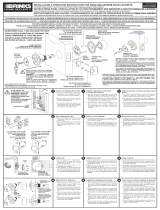 Brinks Home Security 23021-150 Guía de instalación
Brinks Home Security 23021-150 Guía de instalación
-
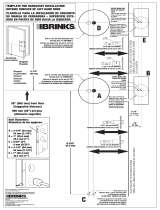 Brinks Home Security 2057-105-1 Instrucciones de operación
Brinks Home Security 2057-105-1 Instrucciones de operación
-
 Brinks Home Security 23042-119 Guía de instalación
Brinks Home Security 23042-119 Guía de instalación
-
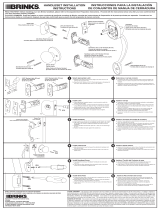 Brinks Home Security 2057-105-1 Guía de instalación
Brinks Home Security 2057-105-1 Guía de instalación
-
Brinks 23092-119 Guía de instalación
-
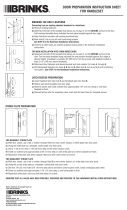 Brinks Home Security 2057-105-1 Guía del usuario
Brinks Home Security 2057-105-1 Guía del usuario
-
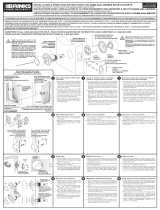 Brinks Home Security 23042-119 Guía de instalación
Brinks Home Security 23042-119 Guía de instalación
Otros documentos
-
Universal Hardware UH40063 Guía de instalación
-
Defiant B87L2 Guía de instalación
-
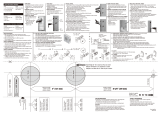 Faultless HMX2G1B Manual de usuario
Faultless HMX2G1B Manual de usuario
-
Universal Hardware UH40066 Guía de instalación
-
Defiant 896753 Manual de usuario
-
Gatehouse LA7X203B Guía de instalación
-
Defiant DLX21-RQLBGS Guía de instalación
-
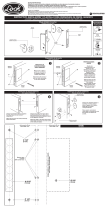 Lock L2101NI El manual del propietario
Lock L2101NI El manual del propietario
-
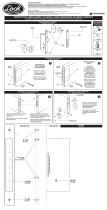 Lock L2101 El manual del propietario
Lock L2101 El manual del propietario
-
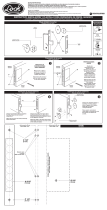 Lock L2102 El manual del propietario
Lock L2102 El manual del propietario











